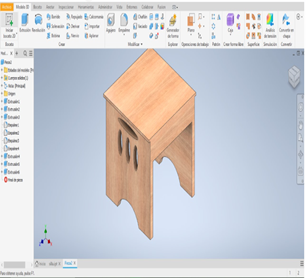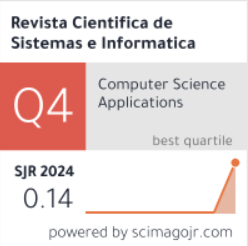Integration of digital manufacturing tools in the development of ergonomic didactic resources: a case study in preschool education
DOI:
https://doi.org/10.51252/rcsi.v5i2.973Keywords:
child learning, CAD design, school ergonomics, computer-aided manufacturing, pedagogical validationAbstract
This study addressed the need to improve the ergonomic conditions of school furniture in early childhood education, considering its impact on children’s posture, safety, and concentration. The objective was to design, manufacture, and validate an ergonomic educational module (desk and chair) for students aged 3 to 5, using digital manufacturing tools. An experimental approach was applied across five phases: collection of anthropometric data, CAD modeling, computer-aided manufacturing (CAM), technical assembly, and structural, ergonomic, and pedagogical validation. The design adhered to international standards (ISO 5970, UNE-EN 1729-2, ISO 7174-1) and guidelines from the Peruvian Ministry of Education (MINEDU). Results showed 92% material utilization efficiency, average production time of 85 minutes, and high structural resistance. Validation with teachers and children demonstrated 94% postural adequacy and high satisfaction levels regarding ergonomics, safety, and functionality. It was concluded that integrating digital manufacturing technologies into the development of ergonomic school furniture is feasible and offers potential for replication and transfer to public early childhood education institutions.
Downloads
References
Baba, A., Shahrour, I., & Baba, M. (2024). Indoor Environmental Quality for Comfort Learning Environments: Case Study of Palestinian School Buildings. Buildings, 14(5), 1296. https://doi.org/10.3390/buildings14051296
Budi, Y. E. P., & Sukmono, T. (2023). Effectiveness of CAD-CAM Application for the Development design and implementation of maintenance tools. Jurnal Penelitian Pendidikan IPA, 9(9), 671–680. https://doi.org/10.29303/jppipa.v9i9.4859
Cardon, G., De Clercq, D., De Bourdeaudhuij, I., & Breithecker, D. (2004). Sitting habits in elementary schoolchildren: a traditional versus a “Moving school.” Patient Education and Counseling, 54(2), 133–142. https://doi.org/10.1016/S0738-3991(03)00215-5
Cash, P., Daalhuizen, J., & Hekkert, P. (2023). Evaluating the efficacy and effectiveness of design methods: A systematic review and assessment framework. Design Studies, 88, 101204. https://doi.org/10.1016/j.destud.2023.101204
Chen, H.-F., & Tsai, C.-Y. (2024). The Impact of School Classroom Chair Depth and Height on Learning Tasks. Education Sciences, 14(6), 661. https://doi.org/10.3390/educsci14060661
Dehghan, S., Sattarpanah Karganroudi, S., Echchakoui, S., & Barka, N. (2025). The Integration of Additive Manufacturing into Industry 4.0 and Industry 5.0: A Bibliometric Analysis (Trends, Opportunities, and Challenges). Machines, 13(1), 62. https://doi.org/10.3390/machines13010062
Esenarro, D., Ccalla, J., Raymundo, V., Castañeda, L., & Davila, S. (2023). Neurostimulating Architecture Applied in the Design of Educational Centers and Early Cognitive Development in the District of Villa El Salvador, Lima. Buildings, 13(12), 3034. https://doi.org/10.3390/buildings13123034
Fazeli, H. R., & Peng, Q. (2022). Generation and evaluation of product concepts by integrating extended axiomatic design, quality function deployment and design structure matrix. Advanced Engineering Informatics, 54, 101716. https://doi.org/10.1016/j.aei.2022.101716
Gumasing, M. J. J., Cruz, I. S. V. Dela, Piñon, D. A. A., Rebong, H. N. M., & Sahagun, D. L. P. (2023). Ergonomic Factors Affecting the Learning Motivation and Academic Attention of SHS Students in Distance Learning. Sustainability, 15(12), 9202. https://doi.org/10.3390/su15129202
Kalita, H., Zindani, D., & Kumar, K. (2019). Additive Manufacturing. In Additive Manufacturing Technologies From an Optimization Perspective (pp. 41–76). https://doi.org/10.4018/978-1-5225-9167-2.ch003
Kantaros, A., Diegel, O., Piromalis, D., Tsaramirsis, G., Khadidos, A. O., Khadidos, A. O., Khan, F. Q., & Jan, S. (2022). 3D printing: Making an innovative technology widely accessible through makerspaces and outsourced services. Materials Today: Proceedings, 49, 2712–2723. https://doi.org/10.1016/j.matpr.2021.09.074
Kraus, S., Jones, P., Kailer, N., Weinmann, A., Chaparro-Banegas, N., & Roig-Tierno, N. (2021). Digital Transformation: An Overview of the Current State of the Art of Research. Sage Open, 11(3). https://doi.org/10.1177/21582440211047576
MINEDU. (2023). Criterios para el Diseño de Mobiliario Educativo de la Educación Básica Regular. https://www.minedu.gob.pe/p/pdf/rvm-n-019-2023-minedu.pdf
Oyetade, K., Zuva, T., & Harmse, A. (2025). Integrating Industry 4.0 technologies into IT education. Cogent Education, 12(1). https://doi.org/10.1080/2331186X.2025.2479195
Podrekar Loredan, N., Kastelic, K., Burnard, M. D., & Šarabon, N. (2022). Ergonomic evaluation of school furniture in Slovenia: From primary school to university. Work, 73(1), 229–245. https://doi.org/10.3233/WOR-210487
Rafiyya, A., Kraiwanit, T., Limna, P., Sonsuphap, R., Kasrisom, A., & Snongtaweeporn, T. (2024). Early childhood social-emotional development: an impact on a developing country. International Journal of Evaluation and Research in Education (IJERE), 13(5), 3081. https://doi.org/10.11591/ijere.v13i5.29462
Rasu, S. (2023). The Future of 3D Printing in Prototype Development: Minimizing Prototype Costs and Decreasing Validation Timelines. Journal of Engineering and Applied Sciences Technology, 1–4. https://doi.org/10.47363/JEAST/2023(5)E134
Soomro, S. A., Casakin, H., & Georgiev, G. V. (2021). Sustainable Design and Prototyping Using Digital Fabrication Tools for Education. Sustainability, 13(3), 1196. https://doi.org/10.3390/su13031196
Tihinen, M., Pikkarainen, A., & Joutsenvaara, J. (2021). Digital Manufacturing Challenges Education—SmartLab Concept as a Concrete Example in Tackling These Challenges. Future Internet, 13(8), 192. https://doi.org/10.3390/fi13080192
Tofail, S. A. M., Koumoulos, E. P., Bandyopadhyay, A., Bose, S., O’Donoghue, L., & Charitidis, C. (2018). Additive manufacturing: scientific and technological challenges, market uptake and opportunities. Materials Today, 21(1), 22–37. https://doi.org/10.1016/j.mattod.2017.07.001
Yan, B., & Wang, Y. (2024). Evaluating the impact of technological development policy on the high-quality development of the manufacturing industry: Mechanisms and threshold effects. Heliyon, 10(16), e35858. https://doi.org/10.1016/j.heliyon.2024.e35858
Yao, K.-C., Chen, D.-C., Pan, C.-H., & Lin, C.-L. (2024). The Development Trends of Computer Numerical Control (CNC) Machine Tool Technology. Mathematics, 12(13), 1923. https://doi.org/10.3390/math12131923

Downloads
Published
How to Cite
Issue
Section
License
Copyright (c) 2025 Fidel Ramos-Ticlla, Enrique Alejandro Barbachan-Ruales, Richar Palomino-Román, Dany César Carhuavilca-Capcha, Miguel Alejandro Barbachan-Villalobos

This work is licensed under a Creative Commons Attribution 4.0 International License.
The authors retain their rights:
a. The authors retain their trademark and patent rights, as well as any process or procedure described in the article.
b. The authors retain the right to share, copy, distribute, execute and publicly communicate the article published in the Revista Científica de Sistemas e Informática (RCSI) (for example, place it in an institutional repository or publish it in a book), with an acknowledgment of its initial publication in the RCSI.
c. Authors retain the right to make a subsequent publication of their work, to use the article or any part of it (for example: a compilation of their works, notes for conferences, thesis, or for a book), provided that they indicate the source of publication (authors of the work, journal, volume, number and date).









